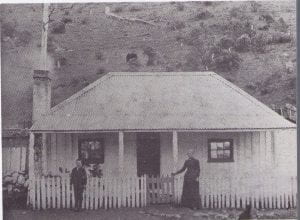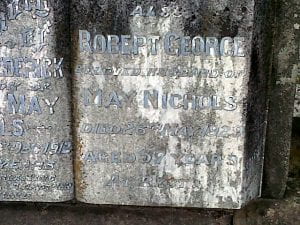 Charlotte May was my third great grandmother. She was born 16 Sep 1842 at Upper Caldecote, Bedfordshire, England to parents James May and Mary Rogers. Charlotte was the third child to be born into the family and at the time of her birth her father, James, was employed as a publican. By 1846 a fourth child had joined the family, who continued to live in the Upper Caldecote area.But the fortunes of the family were soon to change.
Charlotte May was my third great grandmother. She was born 16 Sep 1842 at Upper Caldecote, Bedfordshire, England to parents James May and Mary Rogers. Charlotte was the third child to be born into the family and at the time of her birth her father, James, was employed as a publican. By 1846 a fourth child had joined the family, who continued to live in the Upper Caldecote area.But the fortunes of the family were soon to change.
On the 1851 England Census, the family’s circumstances had changed drastically. The eldest in the family had gone ‘into service’ and at the age of 15 is shown still living in Upper Caldecote, at the residence of the Webb family as their servant. However, the rest of the family are living in far for straightened circumstances. Charlotte, along with her mother and father and two siblings are shown as living in the Workhouse in Biggleswade, Bedfordshire. We don’t know how long the family had been living in the workhouse, but one can only hope it wasn’t for an extended period of time. In literature from the 19th century, we are presented with so many stories of the treatment that people received in the workhouses with family units being separated into different sections of the institution. The one thing the workhouse provided them with was food and shelter, so that is something to be thankful for.
Whatever the length of their stay in the workhouse, by 1852 the family’s fortunes had changed yet again: this time for the better. On 2 July 1852 Charlotte arrived in Geelong, Victoria with

Charlotte in her later years
her parents and all three of her siblings on board the ‘London’ as Assisted Immigrants. Charlotte was just 9 years old. The family proceeded to settle in the city of Ballarat, where James May found work as a carpenter. It was here in Ballarat that Charlotte was married at the age of 18 to George Frederick Furlong.
George was a miner by trade, and the couple lived in various mining communities in Victoria. Some places that they lived included Lucknow, Happy Valley, and Springdallah. After four years of marriage, George died from Heart Disease. This left Charlotte a widow at the age of 23, with two very young children (a 2 year old and an 11 month old) to look after. Fortunately, Charlotte’s bother was living in the vicinity (he was actually the informant on the death certificate) so she at least would have had some family support at such a difficult time.

Image taken from ‘Joadja Creek: The shale oil town and its people 1870-1911’ by Leonie Knapman
Charlotte presumably stayed in the Springdallah area, as by 1870 she was living at nearby Golden Lake where she was a lodging house keeper. It was here at Golden Lake, in the very house that she was living, that Charlotte married her second husband John Gavin Henderson. Now, I have to admit that I have failed to notice until I went to write this post that Charlotte was a lodging house keeper and that the marriage took place at her place of residence. Now, these facts have me wondering if perhaps John Gavin Henderson was one of her lodgers? He was a single man, so perhaps this is how they met but it’s one of those things we will most likely never know for certain.
Whatever the case, Charlotte had married again and to another miner. The

Charlotte Henderson with four of her children. (Image courtesy of P. Rawson)
couple lived in the Golden Lake area for at least the next four years, which we can track through the births of their first two children. However, the couple appears to have moved around after that. Again, this movement can be traced by the births of their children. From Golden Lake, Victoria they moved to Wallsend, NSW (another mining town) where the couple’s first son was born and also where their eldest daughter died at the age of 5 years old. From there, it was down the Blue Mountains to Hartley Vale, NSW where another daughter was born in 1879. Two years later, the couple were located in Joadja Creek (near Mittagong, NSW). Two events of note happened here, one which would change Charlotte’s life yet again.
In 1881, Charlotte’s second husband John Gavin Henderson was killed in a railway accident at the Joadja Creek mining site. At the time, Charlotte had three children aged 7, 5, and 2 years old. She was also seven months pregnant at the time of her husband’s death. So, Charlotte was now a widow twice over at the age of 38. But, Charlotte picked herself up form yet another loss and continued to stay in Joadja where she worked as an emergency nurse and midwife.

The Henderson House in Joadja Creek (‘Joadja Creek’, Leonie Knapman)
Charlotte raised her young family in the community of Joadja Creek, with her children meeting and marrying future spouses in the township. It’s not certain, how long Charlotte stayed in Joadja but the township itself was deserted in 1911 after the shale mining operation was shut down and is now a ghost town. What is known, is that Charlotte eventually moved to the Newcastle area where her daughter May was living with her family. It was here on 3 September 1919 that Charlotte died from a bowel obstruction, aged 76 years of age. The Newcastle Morning Herald and Miners’ Advocate announced on September 4 that her funeral would leave Newcastle hospital at 2 o’clock that afternoon for Sandgate Cemetery, which would be her final resting place.

Charlotte’s Headstone at Sandgate Cemetery, Newcastle
All information about Joadja Creek township in this post is taken from the book ‘Joadja Creek: The shale oil town and its people’ by Leonie Knapman (1988). Some photos were taken from the publication, and this has been indicated in the captions of the individual photos.
 R is for Robert George Nichols, my 2nd great grandfather. Unlike some other ancestors of mine, Robert had a life in quite a few different places, moving around from place to place throughout his life.
R is for Robert George Nichols, my 2nd great grandfather. Unlike some other ancestors of mine, Robert had a life in quite a few different places, moving around from place to place throughout his life.



 Charlotte May was my third great grandmother. She was born 16 Sep 1842 at Upper Caldecote, Bedfordshire, England to parents James May and Mary Rogers. Charlotte was the third child to be born into the family and at the time of her birth her father, James, was employed as a publican. By 1846 a fourth child had joined the family, who continued to live in the Upper Caldecote area.But the fortunes of the family were soon to change.
Charlotte May was my third great grandmother. She was born 16 Sep 1842 at Upper Caldecote, Bedfordshire, England to parents James May and Mary Rogers. Charlotte was the third child to be born into the family and at the time of her birth her father, James, was employed as a publican. By 1846 a fourth child had joined the family, who continued to live in the Upper Caldecote area.But the fortunes of the family were soon to change.



